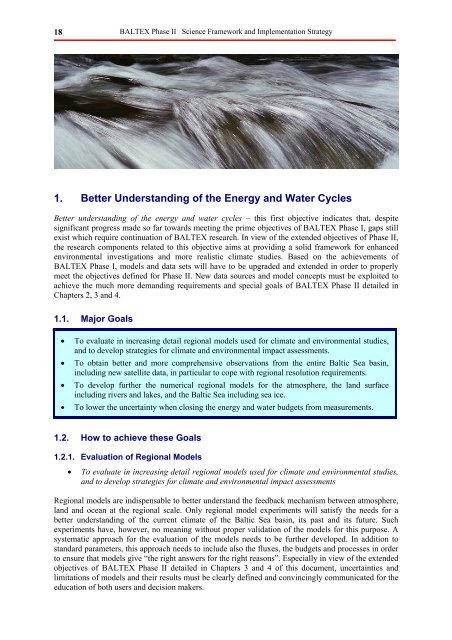BALTEX Phase II 2003 â 2012. Science Framework and ...
BALTEX Phase II 2003 â 2012. Science Framework and ...
BALTEX Phase II 2003 â 2012. Science Framework and ...
Create successful ePaper yourself
Turn your PDF publications into a flip-book with our unique Google optimized e-Paper software.
18<br />
<strong>BALTEX</strong> <strong>Phase</strong> <strong>II</strong> <strong>Science</strong> <strong>Framework</strong> <strong>and</strong> Implementation Strategy<br />
1. Better Underst<strong>and</strong>ing of the Energy <strong>and</strong> Water Cycles<br />
Better underst<strong>and</strong>ing of the energy <strong>and</strong> water cycles – this first objective indicates that, despite<br />
significant progress made so far towards meeting the prime objectives of <strong>BALTEX</strong> <strong>Phase</strong> I, gaps still<br />
exist which require continuation of <strong>BALTEX</strong> research. In view of the extended objectives of <strong>Phase</strong> <strong>II</strong>,<br />
the research components related to this objective aims at providing a solid framework for enhanced<br />
environmental investigations <strong>and</strong> more realistic climate studies. Based on the achievements of<br />
<strong>BALTEX</strong> <strong>Phase</strong> I, models <strong>and</strong> data sets will have to be upgraded <strong>and</strong> extended in order to properly<br />
meet the objectives defined for <strong>Phase</strong> <strong>II</strong>. New data sources <strong>and</strong> model concepts must be exploited to<br />
achieve the much more dem<strong>and</strong>ing requirements <strong>and</strong> special goals of <strong>BALTEX</strong> <strong>Phase</strong> <strong>II</strong> detailed in<br />
Chapters 2, 3 <strong>and</strong> 4.<br />
1.1. Major Goals<br />
• To evaluate in increasing detail regional models used for climate <strong>and</strong> environmental studies,<br />
<strong>and</strong> to develop strategies for climate <strong>and</strong> environmental impact assessments.<br />
• To obtain better <strong>and</strong> more comprehensive observations from the entire Baltic Sea basin,<br />
including new satellite data, in particular to cope with regional resolution requirements.<br />
• To develop further the numerical regional models for the atmosphere, the l<strong>and</strong> surface<br />
including rivers <strong>and</strong> lakes, <strong>and</strong> the Baltic Sea including sea ice.<br />
• To lower the uncertainty when closing the energy <strong>and</strong> water budgets from measurements.<br />
1.2. How to achieve these Goals<br />
1.2.1. Evaluation of Regional Models<br />
• To evaluate in increasing detail regional models used for climate <strong>and</strong> environmental studies,<br />
<strong>and</strong> to develop strategies for climate <strong>and</strong> environmental impact assessments<br />
Regional models are indispensable to better underst<strong>and</strong> the feedback mechanism between atmosphere,<br />
l<strong>and</strong> <strong>and</strong> ocean at the regional scale. Only regional model experiments will satisfy the needs for a<br />
better underst<strong>and</strong>ing of the current climate of the Baltic Sea basin, its past <strong>and</strong> its future. Such<br />
experiments have, however, no meaning without proper validation of the models for this purpose. A<br />
systematic approach for the evaluation of the models needs to be further developed. In addition to<br />
st<strong>and</strong>ard parameters, this approach needs to include also the fluxes, the budgets <strong>and</strong> processes in order<br />
to ensure that models give “the right answers for the right reasons”. Especially in view of the extended<br />
objectives of <strong>BALTEX</strong> <strong>Phase</strong> <strong>II</strong> detailed in Chapters 3 <strong>and</strong> 4 of this document, uncertainties <strong>and</strong><br />
limitations of models <strong>and</strong> their results must be clearly defined <strong>and</strong> convincingly communicated for the<br />
education of both users <strong>and</strong> decision makers.













